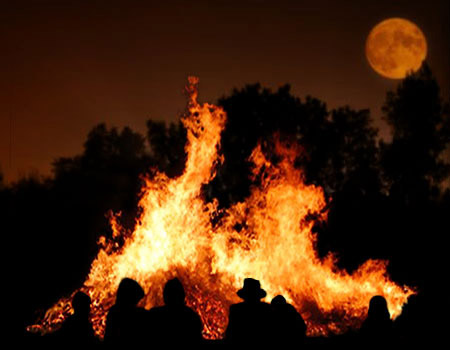By Sabrina Sweeney
Carving a scary face into a pumpkin is a firm favourite in our house at this time of year.
But lately I’ve been thinking there might be merit in keeping a small bonfire going in the garden too, or maybe even trying a bit of divination while I’m at it. Not for Instagram, mind you, but for protection.
Given the state of things politically, socially and otherwise, the old Samhain rituals for warding off evil spirits feel oddly relevant again.
As we approach one of Ireland’s most ancient and meaningful celebrations, that threshold between the old year and the new, I find myself drawn to the customs our ancestors once relied upon. Lighting fires to keep the darkness at bay, wearing disguises so that wandering spirits might pass them by, setting an extra place at the table for those who’d gone before: these were acts of faith in uncertain times.
And when the modern news cycle feels like a never-ending ghost story, perhaps we could all do with a turnip lantern and a few protective chants.
It’s little wonder that these old rituals still speak to us. Uncertainty has become the defining feature of modern life, and when people feel uncertain they reach for clarity even if it’s false.
Complex realities are turned into simple stories of good and bad, right and wrong, and people pick sides because the world seems easier to manage when it’s divided neatly in two.
You can see it in the Irish presidential election, which might once have offered a moment of shared reflection but became like another “us versus them” affair.
With Jim Gavin’s withdrawal, we were left with just two candidates, and that alone set the stage for division. Had there been three, we might have heard more varied arguments and a little common ground. But in a world where debate so often means opposition, two candidates quickly became two camps.
This weekend we’ll have a new president, but regardless of the winner, the sense of division won’t disappear. The way of the world now is such that the sides will keep fighting, left versus right, one tribe against another, with little space left for the middle ground.
Across the Atlantic, American politics has turned this kind of oppositional thinking into a national pastime. Outrage and hatred have become the rhythm of public life.
In contrast, Samhain was never about taking sides. It was about thresholds and the spaces between light and dark, life and death, certainty and mystery. For the people who marked it, ritual wasn’t superstition; it was a practical response to uncertainty.
Lighting fires, carving faces in turnips and fortune telling gave people a way to acknowledge what frightened them and face it together.
Their fears were real: darkness, hunger, loss and the long winter ahead. But by naming those fears and turning them into story and symbol people could make them bearable.
Ritual offered shape where there was none, and community where there might otherwise have been isolation.
Some might find those customs strange now, but the instinct behind them isn’t so different from our own. We still live with uncertainty; it’s only our fears that have changed.
We worry about our jobs, our homes, the climate, the future our children will inherit. We fear misinformation, conflict, and the growing sense of division itself.
And because those fears are so vast, we look for ways to contain them, sometimes by oversimplifying, sometimes by retreating into camps.
Maybe that’s why, as the nights draw in, these old customs still pull at us. Not because we believe in spirits necessarily, but because deep down we still need rituals that help us face the heavy and the hard times together.
Whether that’s carving a pumpkin, lighting a candle, or simply gathering around a meal to talk about what’s on our minds, these small acts connect us to something older and steadier than the noise of the moment.
Samhain reminds us that endings and beginnings are never cleanly divided and that uncertainty doesn’t have to mean despair.
Our ancestors knew that the dark season would come. And they also knew it would pass. Maybe that’s the lesson worth keeping: when we face the dark together, there are always brighter days ahead.










